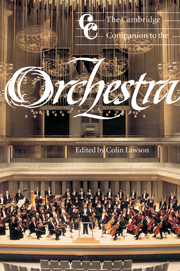Book contents
- Frontmatter
- 1 The history of the orchestra
- 2 The development of musical instruments: national trends and musical implications
- 3 The orchestral repertory
- 4 From notation to sound
- 5 The art of orchestration
- 6 The history of direction and conducting
- 7 International case studies
- 8 The revival of historical instruments
- 9 Recording the orchestra
- 10 Training the orchestral musician
- 11 The life of an orchestral musician
- 12 Historical recordings of orchestras
- 13 The orchestral composer
- 14 Educational programmes
- 15 The future of the orchestra
- Notes
- Appendices
7 - International case studies
Published online by Cambridge University Press: 28 September 2011
- Frontmatter
- 1 The history of the orchestra
- 2 The development of musical instruments: national trends and musical implications
- 3 The orchestral repertory
- 4 From notation to sound
- 5 The art of orchestration
- 6 The history of direction and conducting
- 7 International case studies
- 8 The revival of historical instruments
- 9 Recording the orchestra
- 10 Training the orchestral musician
- 11 The life of an orchestral musician
- 12 Historical recordings of orchestras
- 13 The orchestral composer
- 14 Educational programmes
- 15 The future of the orchestra
- Notes
- Appendices
Summary
Introduction
In recent years there has been an increasing amount of comment about changes in national orchestral performing styles and sonorities during the second half of the twentieth century. It has been argued that in the last few decades traditionally individual sounds and stylistic characteristics of orchestras from specific different countries have been all but eroded and replaced by a more internationally uniform sonority and approach that has gradually but steadily arisen. That is a generalised claim, but nevertheless recordings definitely do illustrate how some very distinctive traits that formerly existed in certain orchestras have now largely disappeared. For instance, fifty years ago there were striking differences between many of the colours, timbres and also styles of phrasing that could be heard in French, Italian, German, Russian, English and American orchestras. And as recently as only a quarter of a century ago this was still very much the case with four of the world's leading orchestras from different parts: the Berlin Philharmonic, Leningrad (now St Petersburg) Philharmonic, London Symphony And New York Philharmonic. Their individually recognisable qualities, such as the Leningrad brass players' stridently strong vibrato and often, though not always, very marcato style (similar in most Russian orchestras) and the darker, richer and more generally blending sounds in Berlin existed to a greater or lesser extent, regardless of who was conducting.
- Type
- Chapter
- Information
- The Cambridge Companion to the Orchestra , pp. 126 - 154Publisher: Cambridge University PressPrint publication year: 2003
- 1
- Cited by



